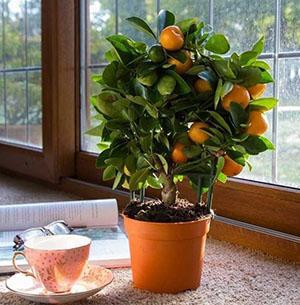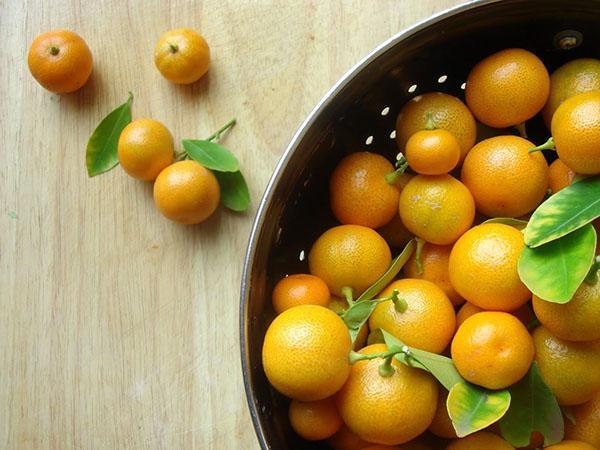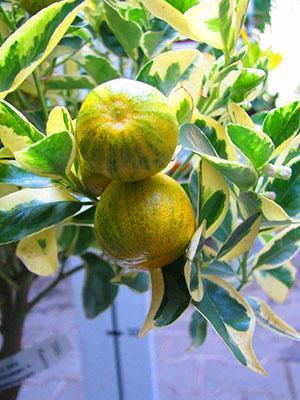Successfully growing Calamondin house
 Calamondin or, as this indoor citrus variety is also called, citrofortunella is a hybrid obtained from crossing the kumquat and loved by many gourmets mandarin... Growing calamondin at home makes it possible not only to replenish the collection with an exotic culture, but also to get bright, small-sized fruits.
Calamondin or, as this indoor citrus variety is also called, citrofortunella is a hybrid obtained from crossing the kumquat and loved by many gourmets mandarin... Growing calamondin at home makes it possible not only to replenish the collection with an exotic culture, but also to get bright, small-sized fruits.
It was thanks to them that the plant received the popular name "golden orange". The small-sized fragrant fruits cover the crown abundantly and sometimes seem fake. Therefore, novice flower growers have a question: "Is it possible to eat calamondin?"

Features of care and cultivation of calamondin
 When kept indoors, the plant forms a compact shrub or an elegant standard tree, although in the open air the culture sometimes reaches five meters in height. For simple home care, citrus calamondin:
When kept indoors, the plant forms a compact shrub or an elegant standard tree, although in the open air the culture sometimes reaches five meters in height. For simple home care, citrus calamondin:
- grows well;
- bears fruit;
- it can be propagated by cuttings or seeds.
Today, indoor plant lovers are offered plants not only with monochromatic foliage, but also variegated forms, in which even the fruits have an unusual striped color.
In the second half of spring, citrus blooms, and then the crown is covered with very odorous, star-shaped flowers of white color. The plant requires manual pollination, after which numerous ovaries are formed on it.
Even a small specimen, with proper feeding and watering, will not throw them off and can bloom when immature fruits still remain on its branches. Calamondin signals discomfort or disturbances in growing conditions by the loss of foliage.
If the right measures are not taken, the plant will die. How to care for Calamondin? What are the requirements for the maintenance and care of this culture?
Caring for citrus with calamondin at home
 For the first time, a florist may encounter wilting and falling foliage several weeks after acquiring a bright plant. The fact is that an exotic perennial is not easy to adapt, and when moving from store to apartment it changes:
For the first time, a florist may encounter wilting and falling foliage several weeks after acquiring a bright plant. The fact is that an exotic perennial is not easy to adapt, and when moving from store to apartment it changes:
- air temperature;
- humidity;
- composition of irrigation water;
- lighting.
In addition, the reasons for the unhealthy and unsuccessful care of citrus with calamondin may lie in the depletion of a fruiting tree from a long stay in the store or insufficient care. Therefore, it is better to transplant the plant, having previously examined and cleaned the root system from dead or rotten fragments. The crown can be covered with a bag to artificially increase air humidity and create a kind of greenhouse.
 Since exotic cultures are not indifferent to the sun, then a place for them must be found on the bright side. True, it is still worth taking care of shelter from direct scorching rays.
Since exotic cultures are not indifferent to the sun, then a place for them must be found on the bright side. True, it is still worth taking care of shelter from direct scorching rays.
Calamondin bought in winter is protected from possible drafts and immediately placed under phytolamps to extend daylight hours. And in the following winters, lighting is required.
At home, growing calamondin does not require the grower to maintain a special temperature.Plants, if all the rules for caring for citrus calamondin are followed, easily tolerate the hot season, and the temperature is considered optimal for them:
- 18-24 ° C in summer;
- 12–16 ° C in winter.
 Plants are hygrophilous and respond well to spraying, which helps them survive the heat. In the cold season, such frequent soil moistening is not required.
Plants are hygrophilous and respond well to spraying, which helps them survive the heat. In the cold season, such frequent soil moistening is not required.
Top dressing can be traditional, combined with irrigation, and foliar. Calamandins need additional nutrition all year round, especially with frequent and abundant fruiting.
If foliar feeding is practiced when caring for calamondin at home, irrigation is best done on the back of the leaves. So it will not be possible to spoil the appearance of glossy sheet plates. Carrying out such procedures is prescribed for the evening, so that the sunbeam burns the place where the drops hit.
Propagation by seeds and cultivation of calamondine from cuttings
Growing calamondine from seeds is a painstaking business and requires great patience. The grower will be able to pick the first fruits only after 6-7 years. You can also get new copies of citrus using cuttings.
 But there are also pitfalls here. In order for the cuttings to take root, you will need:
But there are also pitfalls here. In order for the cuttings to take root, you will need:
- loose substrate for burying the tips of the shoots;
- greenhouse with bottom heating;
- maintaining the temperature of the order of 23-25 ° C;
- long daylight hours.
 Cutting and rooting are best carried out from May to June, when these conditions are easiest to ensure. After the formation of roots, young calamondins are seated in their own pots.
Cutting and rooting are best carried out from May to June, when these conditions are easiest to ensure. After the formation of roots, young calamondins are seated in their own pots.
When choosing pots for transplanting Calamondin, you need to take into account the size of the plant and the growing root system. Therefore, it is better to take bulk containers, where the tree will be comfortable for at least one year.
 When transferring an earthen clod to a new container, it is important not to damage it. And for the outflow of excess moisture, a powerful drainage layer is created at the bottom of the pot. It is calculated so that when the bark system is installed on the soil layer, the root collar, when backfilling, is above the surface of the substrate.
When transferring an earthen clod to a new container, it is important not to damage it. And for the outflow of excess moisture, a powerful drainage layer is created at the bottom of the pot. It is calculated so that when the bark system is installed on the soil layer, the root collar, when backfilling, is above the surface of the substrate.
The soil mixture for growing calamondin is made from ready-made soil for ornamental crops with the addition of humus or from the same humus, twice the amount of turf and sand to impart friability. After the limber, calamondin needs watering, and the first feeding is carried out only a month later.